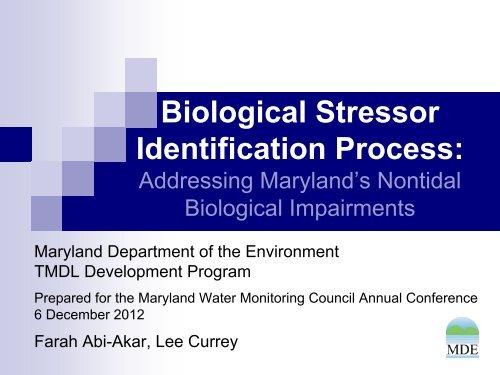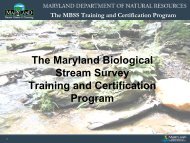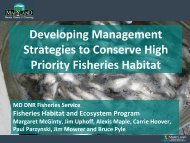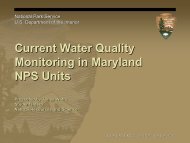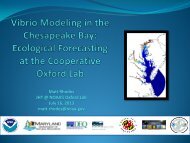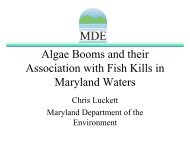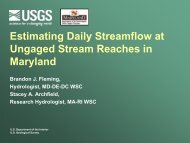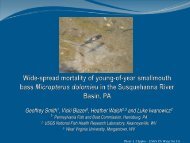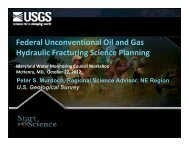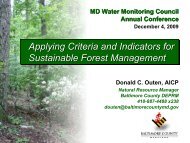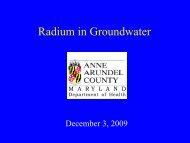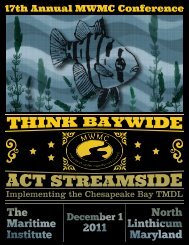Farah Abi-Akar (MDE) - Maryland Department of Natural Resources ...
Farah Abi-Akar (MDE) - Maryland Department of Natural Resources ...
Farah Abi-Akar (MDE) - Maryland Department of Natural Resources ...
Create successful ePaper yourself
Turn your PDF publications into a flip-book with our unique Google optimized e-Paper software.
Biological Stressor<br />
Identification Process:<br />
Addressing <strong>Maryland</strong>’s Nontidal<br />
Biological Impairments<br />
<strong>Maryland</strong> <strong>Department</strong> <strong>of</strong> the Environment<br />
TMDL Development Program<br />
Prepared for the <strong>Maryland</strong> Water Monitoring Council Annual Conference<br />
6 December 2012<br />
<strong>Farah</strong> <strong>Abi</strong>-<strong>Akar</strong>, Lee Currey
Overview<br />
• Background<br />
• Methods<br />
• Results
Background
Background<br />
• Clean Water Act’s Total<br />
Maximum Daily Loads<br />
(TMDLs)<br />
Allowable in-stream limits<br />
Point & non-point sources<br />
Are developed when a Water<br />
Quality Standard is not met,<br />
and when tech. standards<br />
aren’t enough
Background<br />
• MD Water Quality Standards (WQS)<br />
For a body <strong>of</strong> water, the combination <strong>of</strong>:<br />
• A designated use, and<br />
• The water quality criteria designed to protect that<br />
use.<br />
Designated uses include swimming, drinking,<br />
shellfish harvest, protection <strong>of</strong> aquatic life<br />
• DNR’s Benthic Index <strong>of</strong> Biological Integrity (BIBI)<br />
and Fish Index <strong>of</strong> Biological Integrity (FIBI)
Background<br />
• WQS not met <br />
Watershed gets listed on MD’s 303(d) list <strong>of</strong><br />
impaired waters (Integrated Report).<br />
Assessment Unit Designated Use Cause Indicator<br />
Liberty Reservoir<br />
Aquatic Life and<br />
Wildlife<br />
Sedimentation/siltation<br />
Unknown<br />
Liberty Reservoir<br />
Aquatic Life and<br />
Wildlife<br />
Phosphorus (Total)<br />
Dissolved Oxygen<br />
Antietam Creek<br />
Aquatic Life and<br />
Wildlife<br />
Cause Unknown<br />
Fish and Benthic IBIs
Background<br />
• WQS not met <br />
Watershed gets listed on MD’s 303(d) list <strong>of</strong><br />
impaired waters (Integrated Report).<br />
Need a TMDL to fix it.<br />
• Listed for sediment TMDL to reduce sediment.<br />
• Listed for nitrogen TMDL to reduce nitrogen.<br />
• Listed for biology TMDL to reduce… what<br />
–What TMDL(s) should we develop to improve<br />
biology What is making fish & benthics
What is responsible<br />
for reducing fish &<br />
benthics’ biological<br />
integrity<br />
We need to find the guilty<br />
stressors in each watershed.<br />
Round up the suspects and<br />
begin investigation!<br />
Biological<br />
Stressor<br />
IDentification
How the BSID works
Domain<br />
• Freshwater (non-tidal)<br />
• Stream orders 1-4<br />
• 8-digit watershed scale
Data<br />
• DNR’s <strong>Maryland</strong> Biological Stream Survey<br />
Rounds 2 and 3 (2000-2009)<br />
Conditions & biology paired<br />
Most comprehensive<br />
Consistent sampling & analysis methods<br />
• Land use: Chesapeake Bay Program<br />
Spatially consistent (vs: RESAC + NCLD)<br />
More detail in urban areas<br />
Consistent with TMDL Program<br />
• & RESAC Impervious, & State Roads
Data<br />
• Acknowledgements<br />
<strong>MDE</strong> BSID Section<br />
MD DNR MBSS<br />
Chesapeake Bay Program<br />
EPA ORD<br />
University <strong>of</strong> <strong>Maryland</strong><br />
Versar<br />
Programs: SAS and R
Goal: Compare Bio to Stressors<br />
• How Using case-control statistics<br />
Commonly used in epidemiology:<br />
Mantel-Haenszel Odds or Risk Ratios<br />
Categorizes all samples into groups, then<br />
compares numbers in each group.<br />
Groups characterized by:<br />
• Biology: or <br />
• Stressor: Above or Below<br />
• Region and order
Goal: Compare Bio to Stressors<br />
1. Bio<br />
Cases vs. Controls<br />
FIBI < 3<br />
FIBI ≥ 3<br />
BIBI < 3<br />
BIBI ≥ 3<br />
# in 8-digit watershed # in physiographic region
Goal: Compare Bio to Stressors<br />
Controls grouped by:<br />
1. Bio<br />
1 st 2 nd +<br />
Eastern Piedmont<br />
Highland<br />
1 st 2 nd +<br />
1 st 2 nd +<br />
Coastal
Goal: Compare Bio to Stressors<br />
2. Stressors<br />
Potential culprits:<br />
•Habitat<br />
•Sediment<br />
•Water Chemistry<br />
•Acid sources<br />
•Land use – Agriculture<br />
•Land use – Anthropogenic<br />
•Land use – Urban
Goal: Compare Bio to Stressors<br />
2. Stressors<br />
Every 8-digit watershed gets investigated for<br />
every one <strong>of</strong> these stressors.
Goal: Compare Bio to Stressors<br />
2. Stressors<br />
Stressor above limit vs. Stressor below limit
Goal: Compare Bio to Stressors<br />
Stressor Thresholds<br />
2. Stressors<br />
• A.K.A. Defining the line between and <br />
for each stressor<br />
• Some are already defined in COMAR, by<br />
DNR, or in literature, e.g.:<br />
Low lab pH:
Goal: Compare Bio to Stressors<br />
Stressor Thresholds<br />
2. Stressors<br />
• What about stressors without defined<br />
thresholds<br />
High conductivity<br />
Low shading<br />
Low % forest in 60-meter buffer<br />
• Made our own.<br />
Includes R1 & non-random<br />
Nice big sample sizes (72-304)
Goal: Compare Bio to Stressors<br />
Stressor Thresholds<br />
2. Stressors<br />
• Compared stressor levels,<br />
within BIBI & FIBI groups,<br />
within regions.<br />
• 80% confidence intervals<br />
• Strengthen analysis with<br />
bootstrapping (10,000x)
High Conductivity,<br />
Highland<br />
1. Do these overlap<br />
No they are<br />
statistically different.<br />
Threshold set at<br />
mean <strong>of</strong> Fair.
1. Do these overlap<br />
Yes they are not<br />
statistically different.<br />
Low % Forest,<br />
Coastal<br />
2. Do these overlap<br />
No they are<br />
statistically different.<br />
Threshold set at the<br />
mean <strong>of</strong> Poor & Fair.
… for all potential stressors, for all regions.
Goal: Compare Bio to Stressors
Goal: Compare Bio to Stressors<br />
Two-way contingency table: every stressor, every watershed
Goal: Compare Bio to Stressors<br />
• Hypothesis: Sub-par biology will be<br />
correlated to sub-par water quality.<br />
Or,
Goal: Compare Bio to Stressors<br />
Odds Ratio = ad<br />
bc<br />
=<br />
• One odds ratio per watershed, per stressor<br />
• If the OR > 1, the result is significant. The<br />
stressor is likely to be impacting biology.<br />
• Mantel-Haenszel exact test, 90% CI p value
Thanks to odds ratios,<br />
probable stressors<br />
have been ID’d in each<br />
watershed.<br />
Now, how much risk do<br />
we attribute to each
Attributable Risk<br />
• The portion <strong>of</strong> samples with poor to very poor<br />
biological conditions as a result <strong>of</strong> the stressor<br />
The % <strong>of</strong> cases that are the stressor’s “fault”<br />
AR <br />
Proportion<br />
cases<br />
-<br />
Proportion<br />
controls<br />
AR<br />
<br />
<br />
<br />
<br />
a<br />
a<br />
<br />
c<br />
<br />
<br />
<br />
<br />
<br />
<br />
<br />
b<br />
b<br />
<br />
d
Attributable Risk<br />
• ARs are also combined by category:<br />
Stressors<br />
• Sediment<br />
• Habitat<br />
• Water Chemistry<br />
Sources<br />
• Acid sources<br />
• Land use – Agriculture<br />
• Land use – Anthropogenic<br />
• Land use – Urban
Results
Stressor<br />
above<br />
Cases<br />
6<br />
Controls<br />
9<br />
Example:<br />
Seneca Creek,<br />
Impervious Surface<br />
Stressor<br />
below<br />
4<br />
163
Example: Seneca Creek,<br />
Impervious Surface<br />
Cases<br />
Controls<br />
Stressor<br />
above<br />
Stressor<br />
below<br />
6<br />
4<br />
9<br />
163<br />
Odds Ratio ≈<br />
ad<br />
bc ≈ 6*163<br />
9*4<br />
≈ 27<br />
6 9<br />
Attributable Risk ≈ % cases - % controls ≈ - ≈ 55%<br />
10 172<br />
Therefore:<br />
• Yes, impervious surface is a possible bio stressor in<br />
Seneca Creek.<br />
• Estimated risk attributable to impervious surface: 55%
Group Stressor AR<br />
Sources - Agr High % <strong>of</strong> agriculture in watershed 29% 29% 96%<br />
Sources - Low % <strong>of</strong> forest in watershed 45% 47%<br />
Anthropogenic Low % <strong>of</strong> forest in 60m buffer 18%<br />
Sources - Urban High % <strong>of</strong> impervious surface in 60m buffer 49% 59%<br />
High % <strong>of</strong> impervious surface in watershed 55%<br />
High % <strong>of</strong> high-intensity developed in watershed 38%<br />
High % <strong>of</strong> low-intensity developed in watershed 57%<br />
High % <strong>of</strong> medium-intensity developed in watershed 58%<br />
High % <strong>of</strong> early-stage residential in watershed 44%<br />
High % <strong>of</strong> residential developed in watershed 57%<br />
High % <strong>of</strong> roads in watershed 52%<br />
High % <strong>of</strong> high-intensity developed in 60m buffer 19%<br />
High % <strong>of</strong> low-intensity developed in 60m buffer 55%<br />
High % <strong>of</strong> medium-intensity developed in 60m buffer 49%<br />
High % <strong>of</strong> early-stage residential in 60m buffer 25%<br />
High % <strong>of</strong> residential developed in 60m buffer 58%<br />
High % <strong>of</strong> roads in 60m buffer 10%<br />
Sediment Epifaunal substrate poor 18% 18% 96%<br />
Instream Habitat Concrete/gabion present 18% 48%<br />
Instream habitat structure poor 10%<br />
Riffle/run quality marginal to poor 28%<br />
Water Chemistry High chlorides 34% 76%<br />
High conductivity 62%<br />
High orthophosphate 22%<br />
High lab pH 18%<br />
High total nitrogen 54%
Seneca Output: What wasn’t there<br />
• Atmospheric deposition present<br />
• Agricultural acid source present<br />
• AMD acid source present<br />
• Organic acid source present<br />
• High % <strong>of</strong> agriculture in 60m buffer<br />
• Low % <strong>of</strong> wetland in watershed<br />
• Low % <strong>of</strong> wetland in 60m buffer<br />
• High % <strong>of</strong> rural developed in watershed<br />
• High % <strong>of</strong> rural developed in 60m buffer<br />
• Extensive bar formation present<br />
• Moderate bar formation present<br />
• Bar formation present<br />
• Channel alteration moderate to poor<br />
• Channel alteration poor<br />
• High embeddedness<br />
• Epifaunal substrate marginal to poor<br />
• Moderate to severe erosion present<br />
• Severe erosion present<br />
• Silt clay present<br />
• Beaver pond present<br />
• Channelization present<br />
• Instream habitat structure marginal to<br />
poor<br />
• Pool/glide/eddy quality marginal to poor<br />
• Pool/glide/eddy quality poor<br />
• Riffle/run quality poor<br />
• Velocity/depth diversity marginal to poor<br />
• Velocity/depth diversity poor<br />
• No riparian buffer<br />
• Low shading<br />
• Acid neutralizing capacity below chronic<br />
level<br />
• Acid neutralizing capacity below episodic<br />
level<br />
• Dissolved oxygen < 5mg/l<br />
• Dissolved oxygen < 6mg/l<br />
• Low dissolved oxygen saturation<br />
• Low field pH<br />
• High field pH<br />
• Low lab pH<br />
• High sulfates<br />
• Ammonia acute with salmonid present<br />
• Ammonia acute with salmonid absent<br />
• Ammonia chronic with salmonid present<br />
• Ammonia chronic with salmonid absent<br />
• High total phosphorus
# Watersheds Impacted per Stressor<br />
impsurf 1<br />
COND_LAB1<br />
bimpsurf 1<br />
CL1<br />
WB_MURB1<br />
X60M_MURB1<br />
WB_ROAD1<br />
SO4_LAB1<br />
X60M_ROAD1<br />
X60M_LURB1<br />
X60M_FRST1<br />
WB_REHML1<br />
WB_LURB1<br />
EPI_SUB2<br />
X60M_REHML1<br />
X60M_HURB1<br />
CHANNELbin1<br />
X60M_AGRI1<br />
WB_HURB1<br />
WB_FRST1<br />
INSTRHAB2<br />
INSTRHAB1<br />
TP1<br />
EPI_SUB1<br />
VEL_DPTH2<br />
X60M_REEARL1<br />
RIFFQUAL1<br />
WB_REEARL1<br />
LDOSAT_FLD1<br />
DO_FLD2<br />
RIFFQUAL2<br />
POOLQUAL2<br />
O_PHOS1<br />
DO_FLD1<br />
X60M_RUHML1<br />
WB_RUHML1<br />
TN1<br />
RIP_WID1<br />
EMBEDDED1<br />
WB_AGRI1<br />
PH_LAB1<br />
CONCRETEbin1<br />
CHAN_ALT2<br />
WB_WETL1<br />
AR_FORM_MEbin1<br />
POOLQUAL1<br />
CHAN_ALT1<br />
ANC_LAB1<br />
PH_FLD1<br />
ERODSV_Sbin1<br />
ERODSV_Mbin1<br />
BAR_FORM_Ebin1<br />
VEL_DPTH1<br />
SHADING1<br />
X60M_WETL1<br />
PH_LAB2<br />
ACIDAGRbin1<br />
ANC_LAB2<br />
ACIDADbin1<br />
BEAVPNDbin1<br />
ACIDAMDbin1<br />
TANc2bin1<br />
TANc1bin1<br />
PH_FLD2<br />
BAR_FORMbin1<br />
ACIDORGbin1<br />
TANa2bin1<br />
TANa1bin1<br />
SILTCLAYbin1<br />
0<br />
0<br />
0<br />
1<br />
1<br />
1<br />
1<br />
1<br />
8<br />
666<br />
4 55 4<br />
13<br />
13<br />
13<br />
10 11<br />
11<br />
11 12<br />
12<br />
9 10<br />
10<br />
10<br />
17<br />
16 17<br />
17<br />
17<br />
16<br />
15 16<br />
16<br />
16<br />
43 44<br />
35 36 37 43<br />
35<br />
35<br />
34<br />
31 32<br />
32<br />
32 33<br />
33<br />
30<br />
30<br />
29<br />
29<br />
27<br />
27<br />
26<br />
25<br />
20 21<br />
21 22 24<br />
19<br />
19<br />
0 10 20 30 40<br />
Statewide<br />
Top 5 stressors/sources<br />
1. Impervious surface<br />
2. Conductivity<br />
3. Chloride<br />
4. Medium-intensity<br />
development<br />
5. Roads<br />
5. SO 4<br />
Bottom 5 stressors/sources<br />
1. Silt/clay presence<br />
2. Ammonia<br />
3. Organic acid source<br />
4. Bar formation<br />
5. pH > 8.5<br />
Watersheds
BSID Output<br />
• Analysis <strong>of</strong> stressors and interrelationships
BSID Output<br />
• Watershed-specific<br />
reports
Summary<br />
• Challenges<br />
Sample sizes limited<br />
Uncertainty inherent in thresholds<br />
Accounting for “all” stressors<br />
One stressor at a time<br />
• But…<br />
Provides a systematic, quantitative means <strong>of</strong><br />
addressing non-tidal biological impairments.<br />
Analysis strengthened in several ways (sample size,<br />
bootstrapping, land use consistency…)
What’s next<br />
• Analysis <strong>of</strong> results &<br />
interrelationships<br />
• Updating <strong>of</strong> existing reports &<br />
writing new ones<br />
• Development <strong>of</strong> appropriate<br />
water quality criteria and/or<br />
TMDLs to address results
<strong>Maryland</strong> <strong>Department</strong> <strong>of</strong> the Environment<br />
TMDL Development Program<br />
Biological Stressor Identification Section<br />
Allison O’Hanlon<br />
AOHanlon@mde.state.md.us<br />
Shirley Kirby<br />
Skirby@mde.state.md.us<br />
<strong>Farah</strong> <strong>Abi</strong>-<strong>Akar</strong><br />
F<strong>Abi</strong>-<strong>Akar</strong>@mde.state.md.us<br />
BSID Website<br />
http://www.mde.state.md.us/programs/Water/TMDL/<br />
Pages/Programs/WaterPrograms/tmdl/bsid_studies.aspx<br />
1800 Washington Boulevard | Baltimore, MD 21230-1718<br />
410-537-3000 | TTY Users: 1-800-735-2258<br />
www.mde.state.md.us


